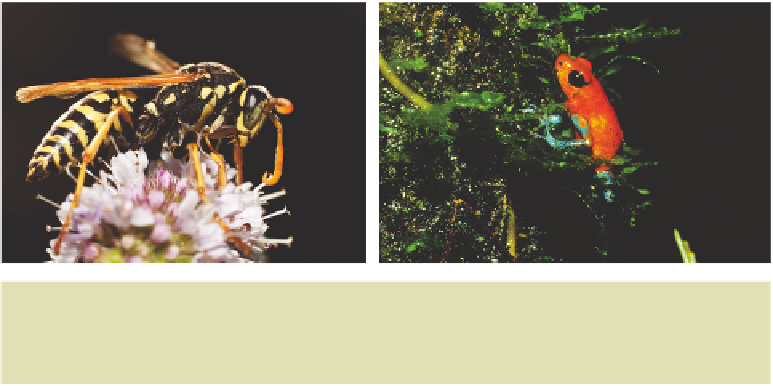Biology Reference
In-Depth Information
domestic chicks as predators and twig-resembling caterpillars as prey, which were
placed in clear view. The birds were divided into three groups: some encountered natural
twigs; some encountered manipulated twigs, bound in purple cotton thread (to change
their visual appearance without influencing their physical structure); and some
experienced an empty arena. The birds were then presented with twig-resembling
caterpillars. Birds with prior experience of natural twigs took longer to attack the
caterpillars and handled them more cautiously compared to birds that had no experience
of twigs, or that had experienced coloured twigs. Therefore, the caterpillars were
detected but misidentified, a true case of masquerade.
Warning colouration: aposematism
Why bright colours?
Some prey are brightly coloured rather than cryptic. Fruit often becomes more brightly
coloured when ripe, which increases the chance that it is eaten and so the seeds are
dispersed. This is an example of a prey which is selected to be eaten by predators. On
the other hand, many prey are also brightly coloured, yet they are presumably selected
to
avoid
predation. Prey often have red, yellow or orange markings, often combined
with black, which makes them especially conspicuous against the green vegetation
(Fig. 4.11).
Bright colours in prey are often associated with repellent defences such as toxins,
spines or stings. For example, the poison frogs (Dendrobatidae) of tropical central
and south America are a monophyletic group with some 210 species. Some are
cryptic and palatable and they tend to have a generalized diet. Others are brightly
coloured (yellow, blue, red or lime green, often combined with black) and they
are highly toxic, deriving at least some of their skin alkaloids from their specialized
diet of ants, termites and mites (Daly
et al
. 2002). This association between
diet specialization and bright colouration has evolved several times independently
Brightly coloured
prey are often
toxic or have
other defences
(a)
(b)
Fig. 4.11
Brightly coloured prey often have repellent defences. (a) A stinging wasp.
Photo © iStockphoto.com/ElementalImaging (b) A red poison dart frog. Photo © Oliver
Krüger.






























